The world’s first national park is nature’s own Disneyland
Of the five ways to enter Yellowstone National Park, the north-east gateway after the descent of Beartooth Mountain Pass surely must be the most exhilarating.
The pass, a 3337-metre ascent to the summit and back down again via hairpin bends with nothing but a knee-high barrier to protect you from a drop to the valley below, is heart-in-mouth.
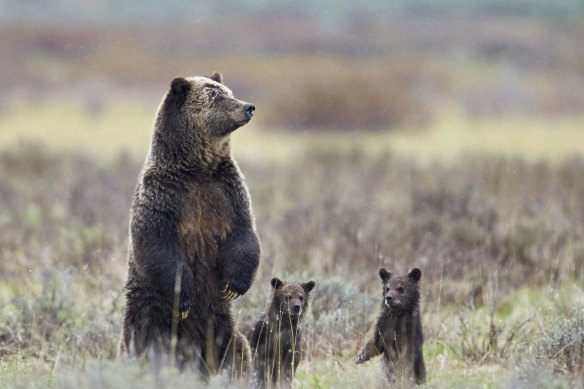
There’s a bear – or 60 – in there.Credit: iStock
Back on the straight-and-narrow, we stop at Silver Gate, Montana (population 20), for a coffee and to recalibrate. Nerves settled and with magnificent views in the rear vision mirror, it’s a five-minute drive to the park.
It’s one of three entrances in Montana and two in Wyoming, all positioned to give day-trippers a good choice of access.
Yellowstone is huge; 8903 square kilometres, with most in Wyoming and 4 per cent in Montana and Idaho. As the oldest US national park and home to 1300 geysers, nine rivers, waterfalls, its own grand canyon and America’s greatest concentration of mammals in the “lower 48 states”, it’s understandably busy.
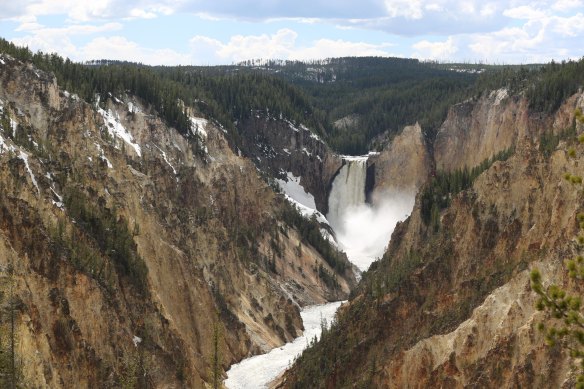
Yellowstone is America’s oldest national park.
The park, nature’s Disneyland, attracts more than 3.5 million people annually so I suggest a simple plan of attack: avoid the weekends and the high summer months.
Within 15 minutes of entering, we see our first bison – a herd of 20, grazing by the roadside with newborn calves, unperturbed.
We slow down to take photos then motor on past rolling green hills on one side and a lazy creek on the other that eventually turns into a fast-flowing river, and snow-dusted mountains on the horizon. This is the Lamar Valley, in the park’s Northern Range, the hub of wildlife in Yellowstone.
More bison amble by and within an hour we spot a bear – a solitary black bear – 50 metres off the road. It’s the first of 15 black and grizzly bears we see over several days. Around another bend, there’s a trio of female elk. It’s a four-legged bonanza even though we’ve just skirted the northern road, yet to venture deeper into the park.
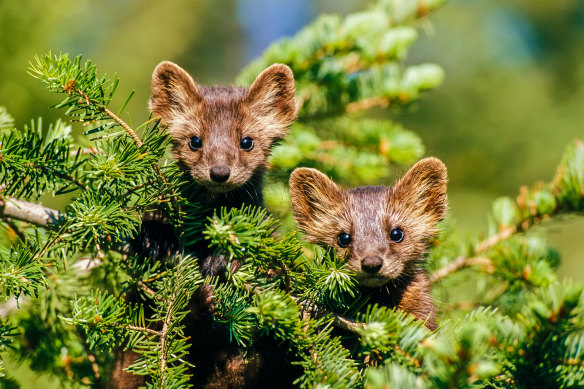
Curiouser and curiouser … American martens.Credit: iStock
As it’s Friday and we have no desire to spend the weekend jostling for parking spots, we head out via Roosevelt Arch, which marks the north entrance, and voila – we’re back in Montana. Any traveller wanting a taste of Yellowstone and a guaranteed wildlife encounter can drive from Silver Gate to the Arch any time, as it’s one of the few roads open year-round.
My driver and long-time friend lives in Montana, so we plan to trip around her state and head back mid-week.
Before visiting Yellowstone, the only knowledge I had was gleaned from watching Yogi Bear. Instantly I’m impressed with how humans and wildlife co-exist and how the thermal sites are so easy to visit, thanks to hundreds of kilometres of roads, excellent boardwalks and superb visitor centres.
It wasn’t always so. Although opened in 1872 as America’s and the world’s first national park, following President Ulysses Grant’s signing of the Yellowstone National Park Protection Act that declared it public land, little protection was actually offered.
Hunters and souvenir collectors plundered wildlife and took away chunks of calcified terraces and geysers, while shrewd entrepreneurs charged visitors for tents and bathing in the springs.
Help was enlisted from the army, which set up Fort Yellowstone in 1886 and administered it until the National Park Service was established in 1918. Based at Mammoth Springs, the fort’s 36 remaining buildings comprise the park’s administrative headquarters and museum, and its lawns are home to a herd of wild elk.
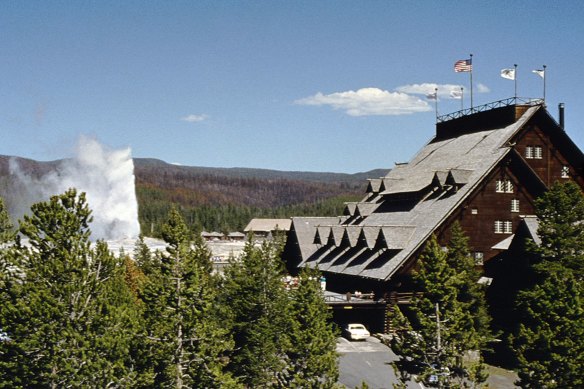
Close to the action … Yellowstone National Park Old Faithful Inn.
A few days later we’re back and spend the night in West Yellowstone, a classic tourist town in Montana that grew up a kilometre from the park’s west entrance, the busiest of the five gates. It makes sense to get up early to beat the crowds (they say there is a 1.5-hour queue to get in during the summer), so we book a 6am pick-up with tour operator Yellowstone Safari Company.
Our guide, Nate, reassures us that despite the lashing rain, wildlife are most active in the morning and not the least worried about the weather. He’s hoping we’ll see grey wolf (there’s a 50-50 chance) and bear and knows we’ll see bison. Today there are about 6000 bison in the park, remarkable considering there were just a few hundred in the US in the late 1880s, including those on private ranches; millions of the animals, which ironically are the nation’s emblem, were hunted to near extinction. They are the most dangerous of the park’s animals and prolific signs warn visitors to keep a 23-metre distance, despite the lure of the selfie.
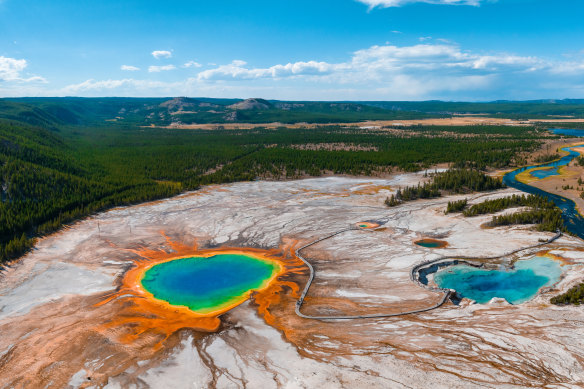
Grand Prismatic Spring is a highlight.Credit: Adobe Stock
We travel along the Gibbon River, then swing left onto the Grand Loop, the main 230-kilometre thoroughfare, resembling a misshapen figure-eight, which travels to the park’s major sites. There’s a north and south loop, intersecting at Canyon Village, roughly in the centre. We pull up at Roaring Mountain, a mini-hill pumping out steam from a dozen fumaroles and then pass by Obsidian Cliff.
Composed of igneous rock formed by rapidly cooling lava, this landform produced flint as sharp as surgical scalpels used by Native Americans for tool-making some 10,000 years ago.
We stop at Mammoth Hot Springs, one of the park’s highlights where a series of boardwalks wind past travertine terraces with names like Cleopatra and Minerva, formed when hot springs rise through calcium carbonate and deposit calcite. Not long afterwards, we spot a cinnamon bear, a subspecies of black bear, and two cubs gambolling in the long spring grasses; next we spy roan pronghorn sheep and sandhill cranes and their young, but no wolf. It’s a shame, but there’s a wolf sanctuary in West Yellowstone, which we later visit.
Overall, we clock up 11 bears for the day, photographed from the recommended distance of at least 91 metres.
For two nights we stay at Canyon Village, the largest of the six accommodation centres in the park and an excellent base to explore the south loop, which has the lion’s share of big-ticket attractions. Next day I stand on the north rim of the Grand Canyon of Yellowstone, which I didn’t even know existed; this gorge 32 kilometres long, 305 metres deep and 1200 metres at its widest point, was created by a volcanic eruption 630,000 years ago. Dozens of hiking trails wind around it, and lookouts provide panoramic views. We opt for the short but seriously steep route down to Red Rock Point for a close-up view of the Lower Falls (the higher of two falls at 93 metres), which plunge into the Yellowstone River. Later we take the Brink of the Upper Falls walk to stand a metre above the edge of this thunderous cascade.
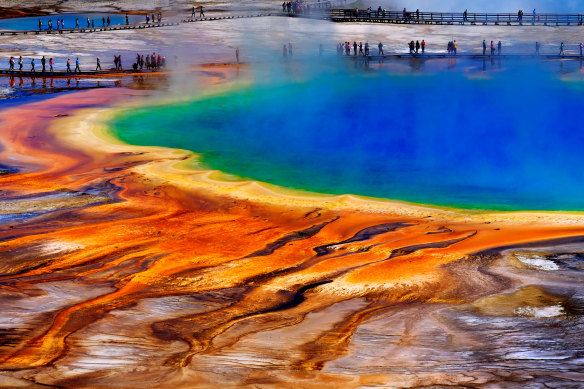
Don’t adjust your screen … the rainbow delights of Grand Prismatice Spring up close.Credit: iStock
From the canyon, we drive to Mud Volcano, another geothermal pocket with a wealth of sights, like Dragon’s Mouth Spring, where waves of hot water ebb and flow through a cavern producing a roaring sound. The path is flanked by Cooking Hillside where the trees have indeed been cooked by steam.
Early explorers called this the “most repulsive and terrifying sight”. Again, my heart’s in my mouth, not because I fear falling in or because I hate the smell, but because we see that bison are on the move. They are milling in the car park and some venture onto the boardwalk and rangers are issuing instructions to keep clear.
We skedaddle and head to the Grand Prismatic Spring, in the Midway Geyser Basin, a park favourite and my pick of the sights as well. It takes its name from the brilliant colours at its perimeter – pink, orange, brown and green – formed by thermophiles or heat-loving microorganisms, and the iridescent blue waters at its centre. With a 113-metre diameter, it is the third largest in the world, after Frying Pan Lake in New Zealand and Dominica’s Boiling Lake.
With 13,000 geothermal features, Yellowstone is a massive hotspot. But no visit is complete without taking a seat, a safe 100 metres away, from the most famous geyser and Yogi Bear’s favourite, Old Faithful. As predicted, 90 minutes after the previous eruption, it blows, sending a plume of boiling water 40 metres into the air, as its steam drifts across the landscape in the late afternoon breeze.
We gasp, applaud, then head into Old Faithful Lodge for a farewell drink.
THE DETAILS
FLY
Bozeman International Airport, Montana, is 144 kilometres from the north entrance of Yellowstone National Park. Delta and United Airlines have services from Australia, with several connections. See delta.com/; united.com
STAY
While prices are cheaper outside the park in West Yellowstone and Silver Gate, Yellowstone National Park has six accommodation centres. Spring and summer accommodation books out quickly; most are closed in winter. Canyon Lodges from $US279 ($440) a night in late May. See yellowstonenationalparklodges.com/
TOUR
Yellowstone Safari Company offers day and multi-day wildlife tours with pickups from Bozeman and West Yellowstone. See yellowstonesafari.com
MORE
See nps.gov/yell
The writer was a guest of the Great American West ( greatamericanwest.com.au) and Yellowstone Safari Company.
Sign up for the Traveller Deals newsletter
Get exclusive travel deals delivered straight to your inbox. Sign up now.